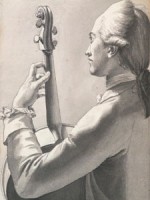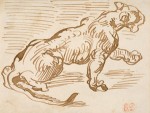Column Name
Title
The Frick Collection’s current exhibition, “Watteau to Degas: French Drawings from the Frits Lugt Collection,” may not sound exciting to most of us. It is both chronological and informational, but don’t let the name fool you. This show is, in fact, awe inspiring, in the original sense of the word. The two rooms downstairs that the Frick devotes to special exhibitions, though relatively small, are guaranteed to take your breath away. The unfamiliarity of the drawings, some by canonic artists and others by little-known ones, comes as a breath of fresh air.
Body
The major thrust of this exhibition is twofold: First, it is a tribute to a collector; and second, it offers a glimpse of the variety possible in the art of drawing.
I don’t know if you have ever considered the “art” of collecting. But if you look at the biography of Frits Lugt (1884-1970), you will learn fascinating facts. The precocious collector had, by the age of 8, sold his shell collection to Amsterdam’s Royal Zoo; at 15 he had acquired his first drawing; and in his 30s he took up collecting quite seriously and with tremendous zeal. Though Dutch and Flemish drawings and prints remained his chief passion, he also bought 15th-century Italian and 18th-century French drawings. He often wrote and lectured about his “passion,” which he believed to be the closest one could come to “a sculptor’s urge to form and shape.” Lugt refuted the notions some put forth that collecting only takes money and that collectors are selfish hoarders; indeed, it was altruism that inspired him to share his treasures with the public. It is, of course, thanks to him that we are fortunate enough to be able to view the present extraordinary show.
I admit that I had never heard the name Lugt before, but it seems that he is to art connoisseurs of Old Master drawings what Ludwig von Köchel is to all lovers of Mozart’s music. Lugt is known by art historians as a cataloguer; a “Lugt number” is used to identify Old Master drawings. Likewise, the name of Köchel (1800-1877) has become just the letter “K” following all of Mozart’s compositions. Both men have been forgotten: Köchel was a 19th-century musicologist and botanist, and Lugt the self-taught art historian and collector who established the Fondation Custodia in Paris in 1947. This now houses more than 7,000 drawings and 30,000 prints. The Frick show is the first public viewing in the United States of French drawings from the collection.
While the exhibition is arranged chronologically, it is not just a survey of works by some of the major artists of 18th- and 19th-century France. It includes drawings by Antoine Watteau, François Boucher, Jean-Honoré Fragonard, Jacques Louis David, J.A.D. Ingres, Eugène Delacroix, and Edgar Degas. But these drawings are not among their best-known ones.
The 64 works the curators at the Frick chose from Lugt’s collection demonstrate an astonishing variety of subject matter. They range from a depiction of 18th-century cello technique to a representation of a slave being thrown to man-eating moray eels. In between, there are images of a giant mollusk, gardens, forests, entertainers, personages, and portraits. Although none of the drawings are by women, we can observe some covert feminism in Pierre-Paul Prud’hon’s Study for a Curtain, which, according to exhibit notes, was made for his “mistress and frequent collaborator, Constance Mayer,” to assist her in a detail in one of her paintings. There is also a tiny 1806 medallion portrait by J.A.D. Ingres of his fiancée, the painter Julie Forestier. Who knew? It turns out that she was also a musician. Ingres made the drawing from a tracing taken from a larger portrayal he had made of the Forestier family. He took this with him to Rome as one would a photograph. He had promised her father that he would return within a year to marry her, but, overstaying his time, he had to break the engagement. Interestingly, both co-curators, Susan Grace Galassi and Colin B. Bailey, have chosen to discuss this intriguing work in podcasts you can hear online.
Prud’hon’s pen and ink drawing, The Cellist (1777-78), was commissioned by the Baron de Joursanvault of Beaune, an amateur musician and patron of the arts. It was one of 12 such drawings illustrating the latter’s treatise on cello technique. We see the cellist (modeled by the baron himself) from the back, but clearly make out his left hand, fingering, and the position with which he holds the cello.
Louis-Jean Desprez’s (1743–1804) The Slaves of Vedius Pollio Thrown Alive to the Moray Eels (1777-79), in pen and gray ink, watercolor over traces of black chalk, delicately depicts a scene, dominated by an arched bridge and classical architecture. But upon closer observation, we are horrified by the predatory eels swimming below, awaiting the body of the unfortunate man suspended in the air on the way to his fate. According to the catalogue, this was once proposed as part of a travel guide to Naples and Sicily, but understandably rejected as too repulsive.
A hugely enlarged seashell (mollusk) once thought to be by Watteau, but probably by another yet-to-be identified artist, could almost be an ancestor of Georgia O’Keeffe’s close-up bones and flowers. The entire drawing, however, is quite small.
Not only is there variety in subject matter, but this exhibit demonstrates how broad the range can be in drawing as to size, medium, and technique. Many of the 18th-century drawings possess delicate cross-hatched streaks of color—a preamble to Impressionism. But there are also the incredibly detailed, almost photographic works of David and Ingres, as well as Delacroix’s drawing of a “wild feline,” done with a free, calligraphic brush.
Drawing has always seemed to me like chamber music. That art form, rather than symphonic music, reveals the most intimate picture of the process of the artist. And this small fraction of holdings from Lugt’s Fondation Custodia has shown me that it should be an obligatory stop in Paris for anyone who loves art. Although I have never been there, it is one collection I shall be sure not to miss on my next visit. It is located on the Rue de Lille, near the Assemblée Nationale.
The drawing show is on only until January 10, but there is another reason to revisit the Frick. They have recently refurbished and rehung their East Gallery and Dining Room. The new installations, together with loans from other institutions, have changed the face of the Frick Collection so familiar to many of us. To see works of art in new and different contexts is almost to see them for the first time.
If you have never been to the Frick, this is a great time to go. If you’ve been there often, it’s a reminder to go back and look with fresh eyes.
“Watteau to Degas: French Drawings from the Frits Lugt Collection” runs through January 10 at the Frick Collection, 1 East 70th Street, at Fifth Avenue. The collection is open Tuesday through Saturday from 10 a.m. to 6 p.m.; Sunday from 11 a.m. to 5 p.m.; it is closed on Monday. www.frick.org.






